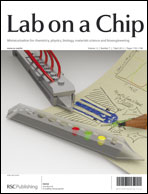On chip steady liquid–gas phase separation for flexible generation of dissolved gas concentration gradient†
Abstract
In this study, steady liquid–gas phase separation is realized by applying a hydrophobic small microchannel array (SMA) to bridge two large microchannels, one for liquid phase and one for gas phase. In this structure, a capillary pressure difference between that in the SMA and the larger channel results in a steady liquid–gas interface. The generated liquid–gas interface allows for fast gas dissolving speed. By coupling the liquid–gas interface with a one directional fluidic field, a steady dissolved gas concentration gradient (DgCG) is generated. The DgCG distribution is easily designable for linear or exponential modes, providing improved flexibility for gas participated processes on chip. To demonstrate its applicability, a CO2 DgCG chip is fabricated and applied for screening CaCO3 crystal growth conditions in the DgCG chip. Crystals with transitional structures are successfully fabricated, which is consistent with the CO2 DgCG distribution.


 Please wait while we load your content...
Please wait while we load your content...